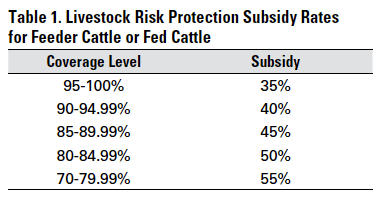Raise Your Competence with Bagley Risk Management
Raise Your Competence with Bagley Risk Management
Blog Article
Comprehending Animals Danger Defense (LRP) Insurance Coverage: A Comprehensive Guide
Browsing the realm of livestock risk defense (LRP) insurance can be a complicated venture for lots of in the farming market. This sort of insurance coverage offers a safeguard against market changes and unpredicted conditions that could influence animals manufacturers. By understanding the ins and outs of LRP insurance policy, manufacturers can make informed decisions that may protect their procedures from economic dangers. From how LRP insurance coverage works to the various protection choices offered, there is much to uncover in this detailed overview that can possibly form the method livestock producers approach danger administration in their companies.
How LRP Insurance Coverage Works
Sometimes, recognizing the auto mechanics of Livestock Threat Defense (LRP) insurance can be intricate, yet damaging down exactly how it works can provide clearness for farmers and breeders. LRP insurance is a danger administration tool created to safeguard livestock producers versus unanticipated cost declines. It's crucial to keep in mind that LRP insurance policy is not an earnings guarantee; instead, it concentrates exclusively on price danger security.
Qualification and Coverage Options

When it comes to coverage options, LRP insurance offers producers the adaptability to select the coverage level, coverage duration, and endorsements that best fit their risk administration requirements. By comprehending the eligibility standards and protection alternatives available, animals manufacturers can make enlightened decisions to handle danger successfully.
Pros and Cons of LRP Insurance Coverage
When evaluating Animals Risk Defense (LRP) insurance policy, it is necessary for animals producers to evaluate the disadvantages and benefits inherent in this danger monitoring tool.

One of the main advantages of LRP insurance policy is its ability to give defense against a decrease in animals prices. Furthermore, LRP insurance coverage uses a degree of adaptability, enabling producers to personalize protection degrees and plan durations to fit their details requirements.
Nonetheless, there are also some drawbacks to take into consideration. One limitation of LRP insurance coverage is that it does not protect against all types of dangers, such as disease outbreaks or natural calamities. In addition, costs can sometimes be costly, particularly for producers with large animals herds. It is critical for manufacturers to meticulously evaluate their individual threat direct exposure and monetary scenario to determine if LRP insurance coverage is the best danger management tool for their procedure.
Comprehending LRP Insurance Policy Premiums

Tips for Taking Full Advantage Of LRP Benefits
Making best use of the advantages of Livestock Threat Protection (LRP) insurance policy requires tactical planning and positive danger management - Bagley Risk Management. To maximize your LRP coverage, consider the following tips:
Frequently Evaluate Market Problems: Keep informed regarding market fads and rate variations in the animals sector. By keeping track of these elements, you can make educated decisions about when to purchase LRP coverage to protect against potential losses.
Establish Realistic Insurance Coverage Degrees: When choosing protection levels, consider your production costs, market price of visit this site right here livestock, and potential risks - Bagley Risk Management. Setting realistic coverage degrees makes certain that you are sufficiently secured without overpaying for unnecessary insurance policy
Expand Your Protection: Instead of relying solely on LRP insurance, consider diversifying your threat administration strategies. Incorporating LRP with other danger monitoring devices such as futures contracts or options can provide thorough protection against market unpredictabilities.
Evaluation and Adjust Insurance Coverage Frequently: As market conditions change, occasionally review your LRP coverage to guarantee it straightens with your present risk direct exposure. Readjusting insurance coverage degrees and timing of acquisitions can assist optimize your threat protection approach. By adhering to these ideas, you can take full advantage of the more info here benefits of LRP insurance coverage and guard your animals operation versus unforeseen risks.
Conclusion
To conclude, livestock danger protection (LRP) insurance coverage is an important tool for farmers to manage the economic threats related to their animals procedures. By recognizing just how LRP works, eligibility and coverage options, as well as the benefits and drawbacks of this insurance policy, farmers can make informed choices to safeguard their livelihoods. By very carefully considering LRP costs and applying strategies to make the most of advantages, farmers can minimize potential losses and ensure the sustainability of their procedures.
Animals producers interested in obtaining Animals Risk Defense you could check here (LRP) insurance coverage can explore an array of eligibility criteria and insurance coverage options customized to their details livestock procedures.When it comes to insurance coverage alternatives, LRP insurance coverage supplies manufacturers the adaptability to pick the coverage level, insurance coverage duration, and recommendations that ideal match their threat management demands.To grasp the complexities of Livestock Risk Protection (LRP) insurance totally, recognizing the variables affecting LRP insurance policy costs is vital. LRP insurance policy costs are identified by various elements, including the insurance coverage degree selected, the expected rate of livestock at the end of the coverage duration, the type of animals being guaranteed, and the length of the coverage period.Review and Readjust Protection Frequently: As market conditions transform, regularly review your LRP insurance coverage to ensure it straightens with your present risk direct exposure.
Report this page